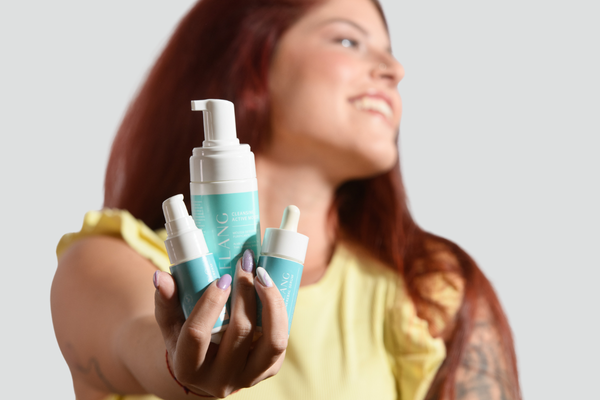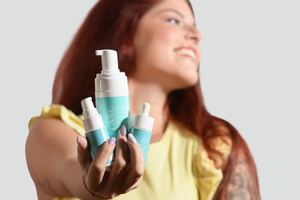Introduction
Red skin is an increasingly common condition, also affecting adults without previous dermatological history. Burning, tingling, itching, and the sensation of "tight skin" are signs of inflammation or alteration of the skin barrier. According to a study published in the Journal of the European Academy of Dermatology and Venereology (2020), over 50% of European women reported having sensitive skin.
But what to apply immediately, in the acute phase, to calm the redness and restore the skin to a state of comfort? This article explores the causes and presents the best functional ingredients to soothe red skin, focusing on LeLang Skin Care's Nutralight Sensitive cream.
Causes of Skin Redness
Skin redness represents a visible response of the skin's vascular and immune system to external or internal stimuli. From a dermatological point of view, it is a multifactorial condition involving the integrity of the skin barrier, the inflammatory response, and neurovascular reactivity.
Irritating external factors
The environment we live in directly affects the health of our skin. Extreme climatic factors, such as cold, wind, and sun, alter the skin's osmotic balance causing vasodilation of superficial capillaries and increase of TEWL (trans-epidermal water loss). This phenomenon makes the skin more vulnerable to inflammations, flaking, and tingling sensations.
In addition, urban air pollution represents an invisible but constant threat: the fine dust (PM 2.5), polycyclic hydrocarbons and heavy metals interact with skin cells generating oxidative stress, alteration of the microbiota and reduced barrier function.
The daily use of over-foaming or alkaline cleansers – like many conventional soaps – compromises the hydrolipidic film, eliminating essential epidermal lipids. This results in dehydrated skin, more exposed to allergens and more prone to redness.
Inflammatory or allergic reactions
The use of cosmetics containing synthetic fragrances, sensitizing preservatives (such as parabens or phenoxyethanol), denatured alcohol, or highly concentrated essential oils can induce reactions of the irritant or allergic contact dermatitis (ICD or ACD).
In predisposed or atopic individuals, skin immune imbalance causes even minimal stimuli to provoke an exaggerated response, often accompanied by itching, redness, swelling, or scaling.
Skin barrier dysfunction
When the stratum corneum – composed of ceramides, fatty acids, and cholesterol – is damaged, it is no longer able to retain hydration nor to prevent the penetration of irritating substances. This triggers a vicious cycle: water loss → inflammation → hyperreactivity.
Clinical studies (Proksch et al., J Invest Dermatol, 2008) show how an increase in TEWL is correlated with the severity of symptoms in conditions such as atopic dermatitis and rosacea.
Hormonal, vascular, and psychophysical causes
Among the deeper causes of persistent redness are also hormonal and neurovascular components:
-
Rosacea, couperose, erythema: chronic conditions characterized by prolonged vasodilation, sometimes accompanied by a burning sensation and skin that "pricks".
-
Hormonal imbalances: variations in estrogen and cortisol – typical of pregnancy, menopause, or menstrual cycle – influence skin reactivity, altering sebum composition and vascular tone.
-
Psycho-physical stress: intense emotional stimuli promote the cutaneous release of neuropeptides (such as substance P), which activate mast cells and trigger neuro-inflammatory reactions, worsening redness and sensitivity.
Approaching these causes consciously – with targeted and protective treatments – is the key to restoring skin tolerance and preventing symptom worsening.
Effective Soothing Ingredients to Look For
When the skin is red, the first goal is to quickly calm inflammation and restore the skin barrier. However, not all cosmetic ingredients are suitable for this purpose: it is necessary to rely on selected actives, supported by scientific studies and with high tolerability.
Functional dermocosmetics, the foundation of LeLang formulations, offer a targeted approach that favors soothing, rebalancing, and regenerating ingredients. Below you will find an overview of the most effective actives, each linked to its detailed sheet in the "Ingredients" section of the lelangskincare.com website.
If you want to learn more about the main causes of redness and strategies to prevent it, we also recommend reading the article Reddened Skin: Causes and Prevention.
Anti-inflammatory derived from chamomile. Reduces itching and redness. Source: Srivastava & Shukla, Phytomedicine, 2017.
Moisturizing, healing, also soothes burns and intense redness. Source: Surjushe A., Indian J Dermatol, 2008.
Soothing, rebalancing, and remineralizing. Strengthens the skin microbiota. Source: Pugliese et al., Dermatology Research and Practice, 2018.
Vitamin B3 with anti-inflammatory effect and barrier strengthening. Source: Draelos ZD, Cutis, 2006.
They soothe, decongest, rich in moisturizing mucilages. Source: Evidence-Based Complementary and Alternative Medicine, 2022.
If you want to explore the main causes of redness and strategies to prevent it, we also recommend reading the article Reddened Skin: Causes and Prevention.
For an in-depth look at how to treat sensitive skin with natural actives functionally, consult Sensitive Skin: What to Do to Calm It Naturally.
Nutralight Sensitive: Soothing Functional Cream
High tolerance formula
Nutralight Sensitive is formulated to meet the needs of the most delicate and reactive skin. Its action is based on a precise balance between botanical actives and functional molecules, ideal for treating skin inflammations, redness, and tingling sensations, even in cases of dermatitis, couperose, or post-treatment.
Main active ingredients (INCI)
-
Daucus Carota Sativa (Carrot) Root Oil: Oil rich in beta-carotene and vitamin A, known for its regenerating, antioxidant, and protective properties. It helps strengthen the skin barrier and prevent lipid oxidation that worsens redness.
-
Corylus Avellana (Hazel) Seed Oil: Hazelnut oil with high skin affinity, astringent and rebalancing, which soothes and nourishes without weighing down, ideal for sensitive combination-prone skin.
-
Bisabolol: Chamomile derivative, it exerts a natural anti-inflammatory action reducing itching and redness.
-
Aloe Barbadensis Leaf Juice: Deep moisturizing and soothing, counteracts burning and promotes regeneration of damaged epidermis.
-
Niacinamide: Vitamin B3 that strengthens the lipid barrier, reduces TEWL (water loss) and normalizes skin reactivity.
-
Malva Sylvestris, Calendula Officinalis, Althaea Officinalis Extract: Phyto-soothing complex rich in mucilages, with emollient, re-epithelializing and anti-redness action.
-
Valdieri Thermal Water: Sulfurous hyperthermal water rich in rebalancing minerals with remineralizing action, useful to enhance the barrier effect and skin comfort.
Features
-
Nickel tested
-
Dermatologically tested on sensitive skin
-
Soft texture but non-occlusive

LeLang Skincare Protocol for Reddened Skin
Step 1: Gentle Cleansing
Morning: Detox Mousse (with thermal water)
Evening: Gentle Oil + Detox Mousse (double-phase cleansing)
Step 2: Thermal Water Mist
-
Pro Age (mature or inflamed skin)
-
Multi Vit (young and reactive skin)
Step 3: Treatment with Nutralight Sensitive
-
Apply morning and evening
-
As an SOS pack: apply a generous layer for 10 minutes, then remove the excess
Results Observed by LeLang Partner Pharmacists
-
78%: reduction of redness in 5 days
-
90%: softer, less reactive skin
-
100%: absence of adverse reactions
Conclusion
Red skin is not just an aesthetic nuisance but a clear sign that the skin barrier is suffering. Treating it with generic or, worse, harsh products can worsen the condition and lead to chronic inflammatory states.
A scientific and personalized approach is essential. Modern dermocosmetics, as also demonstrated by clinical data and LeLang formulations, focus on highly tolerable ingredients with soothing efficacy and proven anti-inflammatory action.
Nutralight Sensitive stands out for its dermo-affine composition, the absence of sensitizing actives, and the inclusion of plant-based ingredients with strong rebalancing action. Included in a complete protocol starting from cleansing and ending with targeted hydration, this cream offers real benefits for those suffering from redness and hyper-reactive skin.
Relying on routines validated by experts, pharmacists, and industry professionals is the first step to turning skin fragility into strength. LeLang accompanies every woman (and every man) on a scientific and human journey towards skin balance.
Visit the official website lelangskincare.com to deepen your knowledge, request a consultation, and discover the world of functional dermocosmetics. Red skin must be treated with awareness and gentleness. Soothing ingredients supported by scientific research form the basis of every effective treatment. Nutralight Sensitive, within a structured LeLang protocol, is today one of the most recommended solutions in pharmacies for treating sensitive skin.
Visit the official website lelangskincare.com to learn more.
FAQ - Frequently Asked Questions
What are the causes of skin redness?
Redness can result from environmental factors (wind, cold, sun), from alterations of the skin barrier, from inflammatory conditions like rosacea, or from allergic reactions and sensitizations.
What to apply on red skin?
It is advisable to use soothing products containing ingredients such as bisabolol, aloe vera, thermal water, and niacinamide. Nutralight Sensitive is specifically formulated for this type of need.
What is it called when the skin becomes red?
The medical term is erythema. If the redness is persistent and localized on the face, it could be rosacea or couperose.
What does it mean to have sensitive skin?
Sensitive skin is skin that reacts excessively to generally harmless stimuli, showing redness, burning, itching, or tingling.
How to get rid of sensitive skin?
Through a minimalist, gentle, and functional skincare routine. It is essential to avoid irritants and choose products with actives tested on sensitive skin.
How to calm the skin?
Use soothing, moisturizing, and antioxidant cosmetics. Thermal water and niacinamide are excellent for rebalancing the skin.
What cream to use for sensitive skin?
A cream like Nutralight Sensitive, which contains no fragrances, alcohol, or sensitizing preservatives and includes skin-friendly and soothing actives.
What are the functional substances for sensitive skin?
Bisabolol, aloe vera, niacinamide, mallow and calendula extracts, panthenol, thermal water.
What are the causes of increased skin sensitivity?
Alteration of the skin barrier, excess of aggressive treatments, exposure to environmental factors, stress, hormonal imbalances, and genetics.
What to use for sensitive skin?
Specific products free of common allergens, fragrances, or alcohol, with formulations tested on reactive skin and clinically validated.
Why do I feel my skin is sensitive?
Because the barrier is weakened or altered, or because there are increased neuro-inflammatory responses at the skin level.
What cream to apply for irritated skin?
A cream based on aloe, niacinamide, and bisabolol: all active ingredients that reduce inflammation, redness, and itching.
What to use to reduce inflammation on the face?
Soothing creams with anti-redness ingredients. It is important to avoid scrubs, retinoids, and exfoliating acids until full normalization.
What is the best anti-redness cream for the face?
Formulations like LeLang's Nutralight Sensitive, with anti-inflammatory and moisturizing actives, are among the most effective.
What is an effective anti-inflammatory cream for the skin?
A cream containing scientifically approved ingredients for dermocosmetic use: aloe, niacinamide, soothing botanical extracts.
How to soothe facial redness?
With targeted skincare, avoiding external aggressions and favoring gentle and nourishing routines.
Which cream to use for redness?
A cream like Nutralight Sensitive that acts on inflammatory mechanisms and soothes the skin progressively and durably.
What is a cream that fights redness?
A cream rich in antioxidant, emollient, and soothing actives like the one offered in the LeLang line for sensitive skin.
What is the best thermal water for the face?
Hyperthermal sulfurous thermal waters, like the one from the Valdieri Thermal Baths present in the LeLang line, have demonstrated a high soothing efficacy.
Sources
-
Proksch E. et al. "The skin barrier in atopic dermatitis." J Invest Dermatol. 2008.
-
Srivastava G. & Shukla S. "Efficacy of α-Bisabolol in dermatological disorders." Phytomedicine, 2017.
-
Surjushe A. et al. "Aloe vera: a short review." Indian J Dermatol. 2008.
-
Draelos ZD. "The effect of niacinamide on facial skin." Cutis, 2006.
-
Pugliese et al. "Thermal water and skin barrier repair." Dermatology Research and Practice, 2018.
-
Evidence-Based Complementary and Alternative Medicine, 2022 – "Soothing effects of herbal mucilage compounds on skin inflammation."







